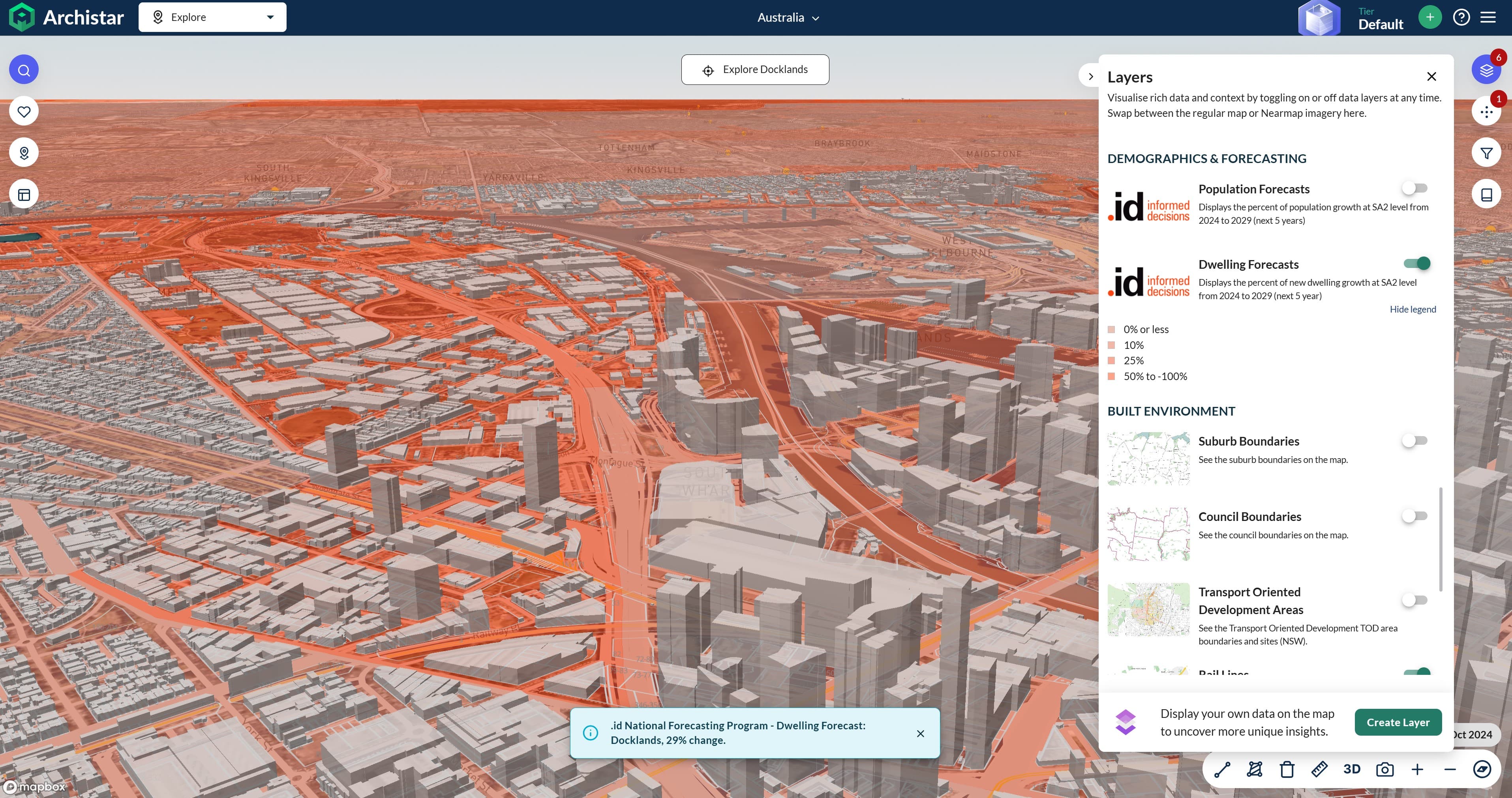When developing population forecasts, we rely on data sources such as the Census to build our knowledge of how Australia’s towns, cities and remote communities are growing and changing over time. We use this knowledge of past patterns to predict how the population will change in the future. So, we have eagerly awaited the release of detailed Census data as an important input into the development of our Small Area Forecast information (SAFi) population forecasts. Please note: SAFi forecasts are separate to .id’s Local Government forecasts (forecast.id).
Developing hyperlocal population forecasts
.id use a range of official statistics and data sources as inputs into our small area population forecasts. This includes inputs from Councils, building approval data, the analysis of aerial photography, property databases and land use changes. Using a variety of ground-level sources allows us to model population forecasts at a detailed, local level that our clients can use to understand population demand at a granular, local geographic level that aligns with their strategic goals.
The 2016 Census triggered updates to a very important dataset for our forecasting work – Australia’s official population count: the Estimated Resident Population (ERP). When developing our small area population forecasts, we use the ERP at a state and territory level, by age and sex, each year, and at a sub-state level for each Census “base” year.
Official statistics published by the Australian Bureau of Statistics (ABS) including the number and location of births and deaths, estimated resident population, and building approvals are incorporated annually. SAFi population forecasts are produced by combining a “tops-down” demographic constraint and combining it with detailed “bottoms-up” assumptions about residential housing stock and how this will change over time.
Ground truthing statistics
Analysis of the preliminary ERP reinforced some concerns we’ve held for a while about the state and territory ERPs. As we spend endless hours examining residential housing development at neighbourhood levels (as the population is directly aligned to the number and type of dwellings in an area), we could see that the ABS official population estimates didn’t always align to what we were seeing on the ground. The ERPs for the ACT for example, were too low – we could see dramatic increases in dwelling stock, which were directly at odd with the official level of population growth. ‘
We can see an example in the aerial photography below for Gungahlin, a suburb of Canberra, where there has been high residential development activity in recent times. This shows greenfield type residential development likely to be family homes that have an average household size consistent with the dwelling stock there previously.
Aerial photography, residential housing development – Gungahlin, Canberra, ACT
Source: Google Earth 2011, 2013, 2015
The high growth in the number of dwellings suggests that the population must be growing at a faster rate than shown in the published ERPs. We observed and validated this using a range of data sources (including building approval data, aerial photography and Cordell data).
Relying on the 2011-based 2016 ERP with the sharp increase in dwelling stock would have meant either the average household sizes were plummeting, or vacancy rates were increasing, both of which we thought to be unlikely at the time.
SAFi dwelling change, SA2s in Gungahlin area, Canberra, ACT
2011-13
|
2013-15
|

|

|
Source: .id SAFi 2016, displaying in .id Placemaker
Our SAFi methodology uses Australia’s official population count, the ERP as a constraint for our demographic assumptions. As we produced our small area population forecasts for the ACT early in 2016, it became apparent that using the ERP may not be possible. The observed increases in dwelling stock and recent increases in levels of overseas migration gain put our figures at odds with the official statistics from the ABS.
Straying from ERP was a decision we don’t take lightly as it’s a departure from our established methodology, and has the potential to be confusing for our clients. In 2016, we bolstered the ERP figure for ACT by transferring 8,100 people from the New South Wales figure (as it is the state with the largest population, and has closest proximity to ACT). This ensured that our population for Australia remained consistent with the published figure.
The table below shows a comparison of the 2011-based and 2016-based ERP (at 30 June 2016). The table shows that our bolstered SAFi population figure for ACT was an effective way of anticipating what we could see happening on the ground. The 2016-rebased figure was much higher than the previously published 2011-based figure. While we overestimated the population by around 1,700 people (0.4%), we view the adjustment as justified based on our knowledge at the time.
Comparison of 2011-based and 2016-based Estimated Resident Population, Australia, States and Territories
Sources/Notes:
1. 2011-base 2016 ERP preliminary status, ABS cat. no. 3101.0, published 15 December 16.
2. SAFi forecast is the adjusted ERP which matches the published ERP as at 30 June 2015, apart from the adjustments discussed in this blog, source Australian Bureau of Statistics, cat. no. 3101.0, March 2016 qtr published 22 September 2016. The 2016 ERP figure produced by SAFi is a forecast based on the most recent published ABS data at the time of production.
3. 2016-base 2016 ERP preliminary status, ABS cat. no. 3101.0, published 27 June 17.
It should be noted that the difference in the ABS’ estimate of population is a usual part of their production process – you can read a more in depth explanation in the feature article: rebasing of Australia’s population estimates using the 2016 Census.
Lessons we learned from using the 2016 Census results
While we remain committed to our standard population forecasting methodology, anomalies such as the ACT adjustment mean that we are continually reviewing the best way to forecast the future population. We are happy to provide our clients with a detailed SAFi methodology paper on request.
Our key learnings include:
- Caution over sole reliance on State and territory level ERPs as constraints for our forecasting work. While ERPs provide a simple and consistent data input, they can also introduce greater levels of uncertainty and reduced confidence in our forecasts.
- Ground truthing makes sense. While .id’s approach is resource-intensive, assessing changes to residential housing stock at the micro-geographic level is time well spent as it illuminates and confronts other data sources, providing a sense-check to official statistics and building a well-rounded knowledge of local places.
- Regular updates are essential. Things can change rapidly on the ground, so regular updates to our SAFi forecasts continue to be important, especially to incorporate changes to officially published data such as the ERP.
.id’s SAFi team is currently in the final stages of updating our small area population forecasts for Victoria. We are using dwelling counts from the 2016 Census, analysed by small area geography (SA1-based, and sometimes sub-SA1 geography). As we finalise our forecasts for Victoria, we will continue to revisit and update our small area forecasts for New South Wales, ACT, and Western Australia.
In analysing the population, we’ve discovered some interesting trends that we will write about in future, such as trends towards living in non-private dwellings, like mining camps in Western Australia. We’ll also look at the use of ‘meshblock’ data and continue to explore how well .id SAFi forecasts perform against State population projections. Stay tuned!
.id is a team of demographers, population forecasters, spatial planners, urban economists, IT and data experts who use a unique combination of online information applications and consulting services to help governments and organisations understand people and places for evidence-based planning.














